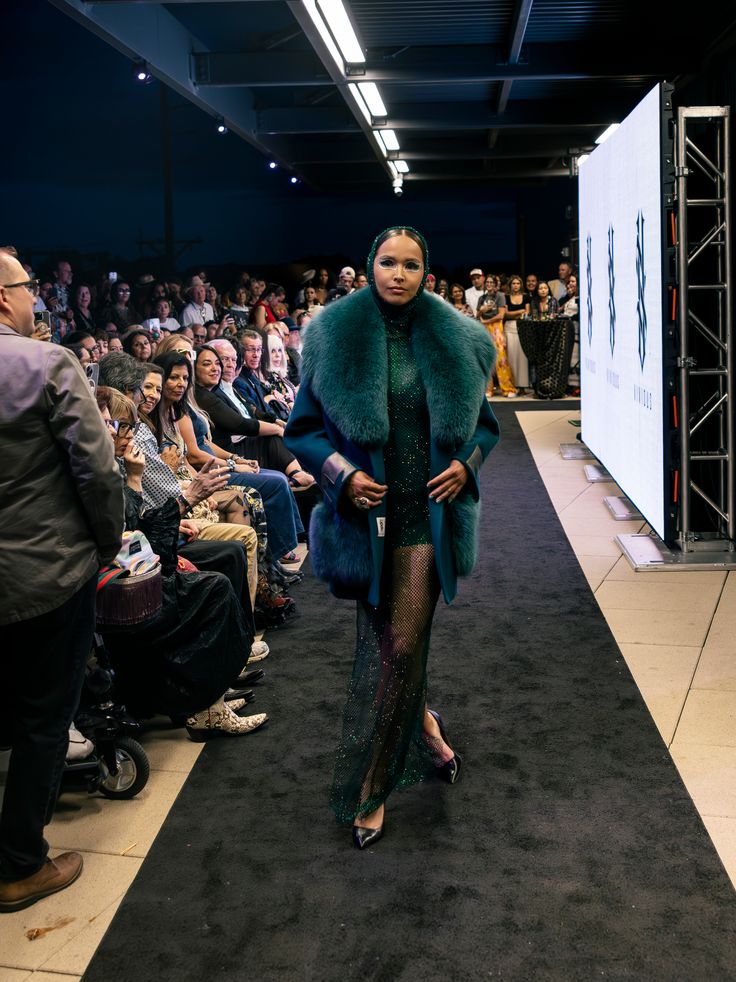Like many girls who came of age in the ’90s, I had aspirations of becoming a model. Thanks to the likes of Cindy Crawford, Christy Turlington and Kate Moss, it was the American dream du jour. After all, their ivory-toned faces and wispy, lithe figures were seemingly everywhere, from countless catwalks to magazine covers to ad campaigns galore; they were impossible to ignore.
The only problem? As an Alaska Native with olive skin, chubby cheeks and broad shoulders, I looked nothing like the supermodels of that era.
It didn’t help that I grew up in rural Minnesota surrounded by mostly blond-haired, blue-eyed kids of Scandinavian descent. Back then, I didn’t understand that my yearning to approximate whiteness actually had very little to do with me and rather was the result of centuries of oppressive assimilation policies intended to make Indigenous people feel inadequate and othered.
I couldn’t change my skin color or my bone structure, but I could manipulate my body size. Thus began a decadeslong battle with body dysmorphia and disordered eating in an ill-fated attempt to become something I’m not.
In my early 20s, I booked a couple of entry-level modeling gigs, but never made my way onto the runway. Even at my gauntest (read: unhealthiest), I still wasn’t tall or thin enough by industry standards, so I called it quits.
It’s only recently that I’ve begun to fully embrace my Tlingit heritage, thanks in large part to an impressive influx of authentic Native American representation across spheres from politics to pop culture. Finally, Indigenous peoples are being celebrated for who we are instead of shamed for who we aren’t. Luminaries such as model and activist Quannah ChasingHorse (Hän Gwich’in and Sičangu/Oglala Lakota) and actor Lily Gladstone (Blackfeet/Nimíipuu) are shattering outdated beauty ideals while honoring their tribal traditions — and helping women like me reclaim our narratives.
In the ensuing years since giving up on those teenage modeling dreams, I’ve endeavored to establish a loving relationship with my body. In my late 30s, I can finally say that I’m well on my way. So it was with surprise, delight, and a bit of trepidation that I considered an unexpected ask from Kashia Pomo/Filipino fashion designer Tierra Alysia: Might I be willing to model for her Vividus brand at the SWAIA Santa Fe Indian Market, only the world’s largest and most prestigious Indigenous art market?
The inspiration behind her newest collection, Alysia explains, is to honor each model’s individual tribal nation with design motifs reflecting their unique heritage. Taken altogether, it’s an ode to Native women and an apt reminder of the rich diversity of Indigenous cultures. Oh, and a percentage of sales of these wearable works of art will support youth programs within each specific community. Of course I was in.
Photo Credit: Serene Power
In the days after my instantaneous acceptance, the magnitude of this opportunity hit me hard in a way I hadn’t expected. It felt like a complete 180 from my younger experiences — not only was I being accepted for who I am, but I was being specifically sought out for who I am.
But as this immense sense of gratitude washed over me, so too did those childhood insecurities as I thought about reentering this image-obsessed industry. Could I hack it with pro models while staying true to myself? Or would I revert back to my days of harsh self-criticism and extreme self-control?
All these questions swirled as I touched down in Albuquerque, New Mexico, to partake in some pre-show photo shoots. Once I set foot inside the picturesque villa Alysia had booked for the occasion and started mingling with the other women — each stunning in their own way — I could tell this was going to be a far cry from my previous fashion world experiences. Throughout the course of the day, we joked, confided and became fast friends.

Credit: Tira Howard for SWAIA
Much like the intricate designs Alysia crafted for the 10 of us to wear, we were far from uniform yet united in our indigeneity. As she showed us the one-of-a-kind wool coats we’d be wearing on the runway — mine was emblazoned with bear chilkat iconography by Tlingit/Koyukon Athabascan artist Amiah Xóotsk’ Johnson — we realized we were part of something pretty extraordinary. Hair stylist Caitlin “Blu” Clark and makeup artist Rayna Rahman, meanwhile, had spent weeks dreaming up looks to complement each unique outfit.
That feeling of sisterhood carried us into the weekend as we prepared for the evening gala, a sold-out affair headlined by French fashion house Balmain in a first for the 102-year-old Indian Market. SWAIA fashion curator and SikSaka historian Amber-Dawn Bear Robe has been working tirelessly to establish Santa Fe as the epicenter of Indigenous fashion, including producing the United States’ first-ever Native Fashion Week earlier this year, which featured Indigenous designers, models and the like. In short, there was no better place for me to make my runway debut.
Support Free Journalism
Support HuffPost
Already contributed? Log in to hide these messages.
As the clock ticked down to show time, the nerves crept in, but that anxiety was assuaged by the kinship I felt with my fellow models. I reminded myself that our unique qualities were the inspiration behind the collection and that I didn’t need to be anyone but me. When I hit that runway, I walked with such immense pride — in myself, in my tribal nation, and in this beautiful community that had formed around me.
During the finale, as all of us models strutted back onto the catwalk and posed one last time, we held hands as a symbol of our interconnectedness and stood tall as shining examples of strong Indigenous women. In that moment, I realized that after a lifetime of uncertainty I’d finally found unconditional love for myself — something I hope today’s Native youth can feel from the very start.
Read the full article here
